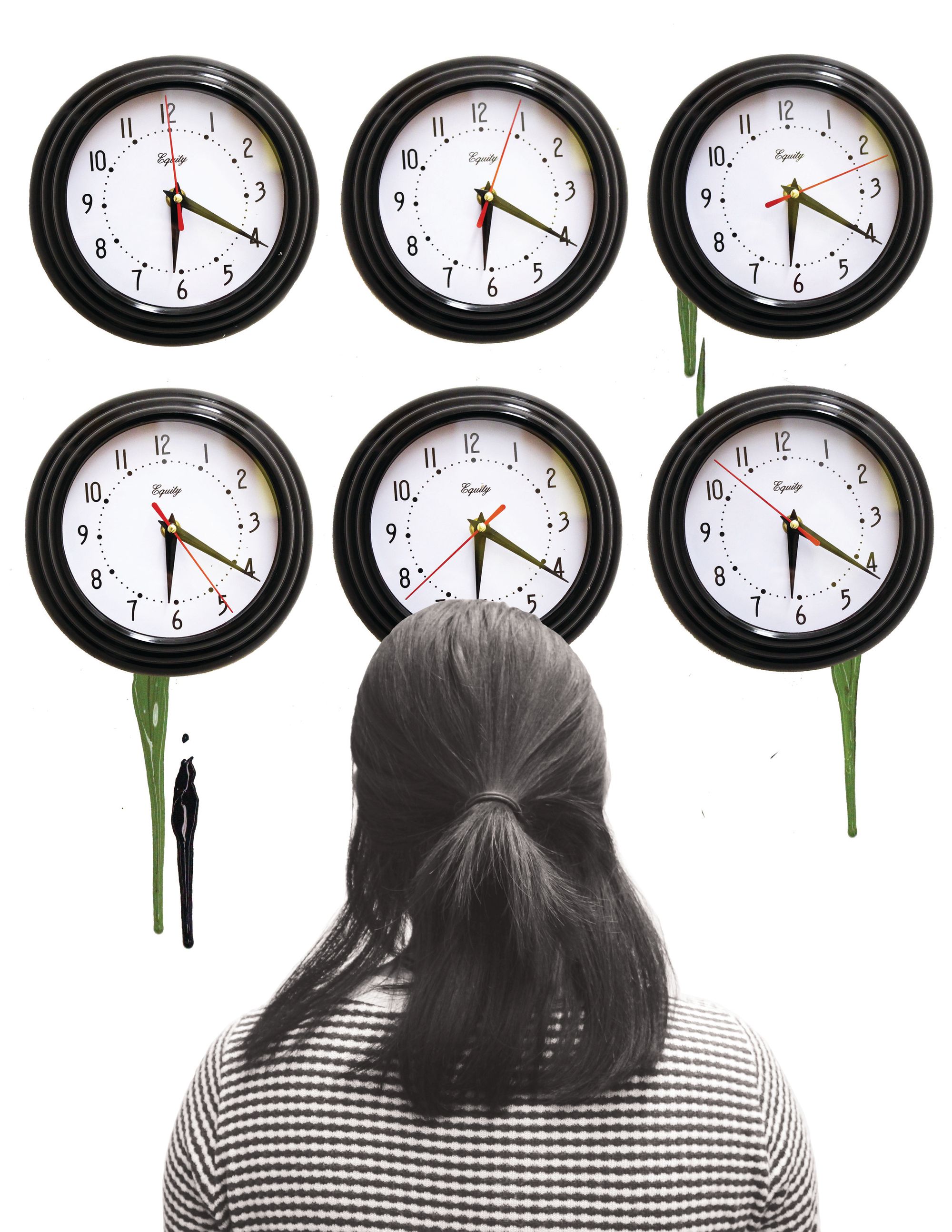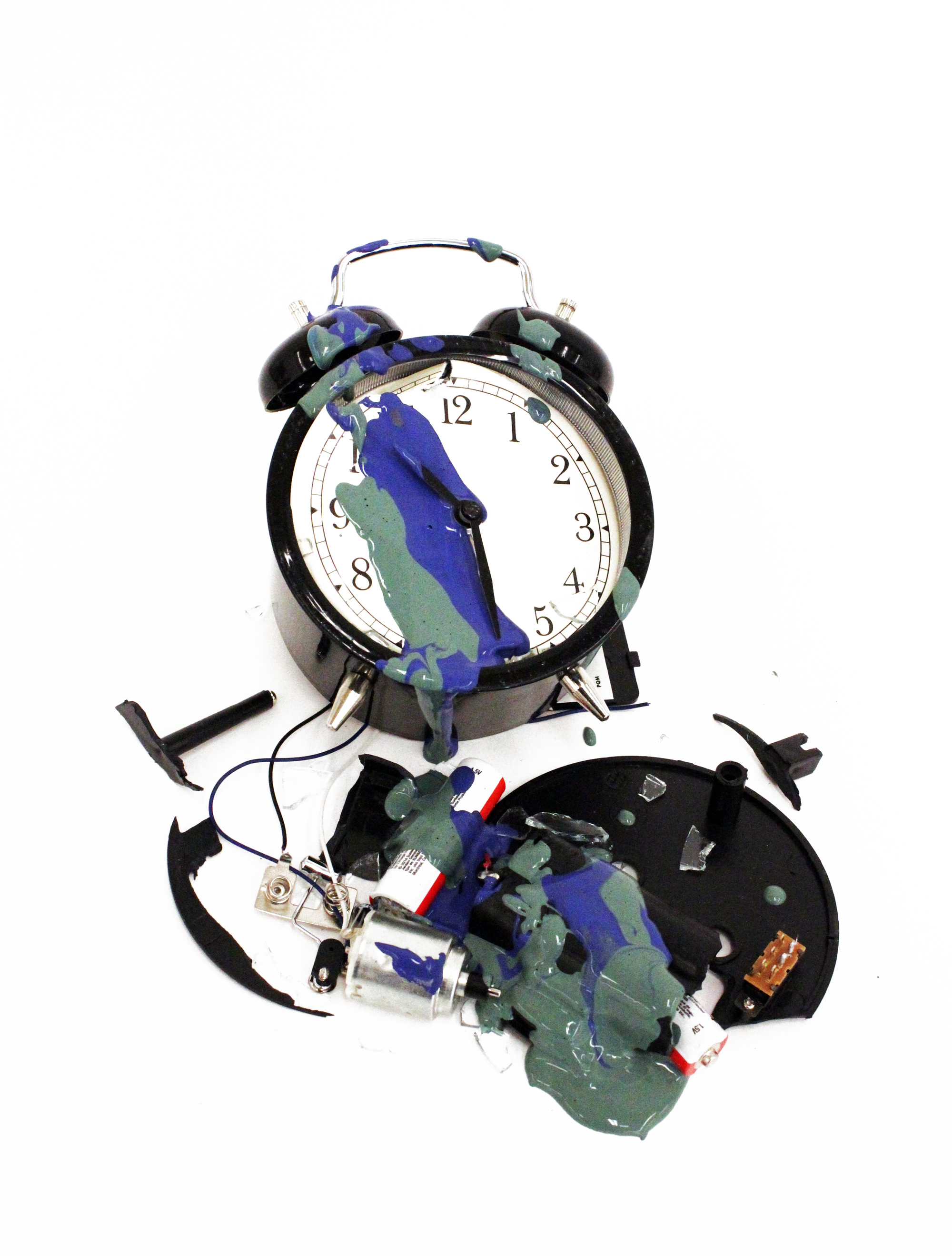The way in which people perceive time depends on the situation they’re in. Imagine sitting in detention, staring at the clock—after sixty ticks of the second hand, the minute hand finally moves one notch. Only fifty-nine more to go. Now consider being at a birthday party, with friends and family gathered around and having a good time. It’s possible that the entire afternoon could whiz by in what could feel like a shorter period of time than that minute in detention. Time perception comes in many forms—from the sensation of time to remembering how long ago something happened or how long an event lasted. Even common tasks like speaking, walking, and listening all require an accurate perception of time, because not all human senses are processed equally quickly [1]. Despite its impact on everyday life, time perception is not well understood—and when it is distorted, it can inhibit a person’s ability to experience life normally.
How the brain perceives time
How a person perceives time varies depending on the duration of time being perceived. The smallest increment we can discriminate is at the microsecond and millisecond time scale, which is necessary for the accurate interpretation of sensory stimuli [1]. For example, someone experiencing normal time perception would correctly hear the word “pocket” if it was spoken. But if the stimuli were not processed correctly, one could hear “po…cket,” or even something like “cket-po”. Time perception at the micro and millisecond level is generally considered to be subconscious, and therefore resistant to distortion. On the other hand, a broader increment of time that humans process are daily cycles known as circadian rhythms. These cycles modulate essential daily behaviors such as eating and sleeping. Since they regulate themselves based off of external stimuli, like light, they can be distorted. Beyond this, humans can also process time increments between these two—for example, within the magnitude of seconds. This is where the largest amount of cognitive distortion is observed, as discernment between seconds relies on conscious perception, which is easily influenced. This means that the perception at the scale of seconds has a much higher rate of inaccuracy than other forms of time perception [1].
Although the exact mechanisms responsible for time perception are unknown, researchers have proposed a number of theories to try to explain it. One such theory is the state model hypothesis, which suggests that timing is encoded by neurons throughout the brain as a byproduct of cells performing their normal functions [2]. The hypothesis suggests that this happens because neurons learn to encode how long ago something occurred as short-term memory, without the aid of a specialized system. In contrast, the internal clock hypothesis claims that specific parts of the brain are responsible for time perception. It proposes that when neurons reach a portion of the brain called the basal ganglia, they fire signals. This allows the basal ganglia to then pass on a signal, which can be normal, or longer or shorter. If the basal ganglia carries the signal normally, then the sensation of time is normal. If the signal is elongated or shortened, however, time can feel longer or shorter. Neither hypothesis has been disproven, and there is experimental evidence for both [2][3].
Time distortion is measured in different ways across different experiments, but many studies examine perceived time durations [4]. This is often done comparatively by presenting stimuli for two different amounts of time and asking subjects which one was longer. When the effect of a disease is being studied, the accuracy of afflicted subjects is compared to the accuracy of healthy subjects. When the effect of different stimuli is being studied, the accuracy of control stimuli is compared to the accuracy of the stimuli being tested. The durations vary, but the model is similar across many experiments. And while these studies often do not examine the mechanism responsible for their results, they do illustrate that there are a variety of ways in which time perception can be distorted.
Dopamine and Time Perception
One factor that has been implicated in time distortion is the neurotransmitter dopamine [3]. Diseases associated with dopamine imbalances such as Parkinson’s Disease, schizophrenia, and depression all appear to have time distortion as a symptom [4][5][6].
Parkinson’s Disease (PD) is a neurodegenerative disease that affects the basal ganglia, an area of the brain that is very important in the execution of movement [7]. PD patients also experience time distortion as a somewhat frequent symptom, which psychologist Dr. Thomas Rammsayer links to the role of dopamine in the condition [8]. It is generally understood that PD is caused by the death of dopamine-producing cells in a part of the basal ganglia called the substantia nigra [6]. Dysfunction in these cells may also be involved in time distortion, as time perception has been shown to be affected by abnormalities in the substantia nigra and dopamine levels [8]. In the Rammsayer experiment, subjects with PD were shown to have a less accurate perception of time than those without. However, when subjects with PD were given a medicine to increase dopamine levels, L-DOPA, average accuracy in their perception of time increased [8]. This suggests that not only are dopamine imbalances possibly related to time distortion in PD, but also that time distortion in the case of PD might be treatable [8].
Subjects with schizophrenia also experience time distortions [4]. Because people with schizophrenia often experience auditory and visual hallucinations, prior studies focused on time distortion within auditory stimuli [9]. However, neuroscientist Dr. Deana Davalos conducted a study investigating time distortion across both the auditory and visual systems in people with schizophrenia. This study was unprecedented, as it investigated whether time distortion was localized in the auditory system or if multiple senses were affected. In doing so, Davalos found that time distortion was present for both visual and auditory stimuli [9]. It is unknown why this occurs, as researchers did not present a hypothesis on the possible physiological mechanisms. Other studies suggest, however, that schizophrenia may involve the overproduction of dopamine [4]. Given that both PD and schizophrenia involve dopamine imbalances and time distortion, it is possible that these two factors are related.
Depression was also found to have an effect on time perception [6]. Neuroscientist Dr. Sven Thones found that the time perception of depressed participants versus those who had not experienced depression (control subjects) was mostly similar. This study incorporated another factor, however, which allowed subjects to self-report their feelings about time passing. Depressed patients reported feeling that time was passing slower; however, depressed subjects and control subjects did not have significant differences in the accuracy of their estimates of time durations. This indicates that depressed subjects did not have lower accuracy in their perception of time, despite their feelings of time distortion. The experiment did not attempt to figure out why this was the case, but Dr. Thones’ team noted that it is possible that dopamine imbalance played a role, as depression is a mental illness caused by abnormal quantities of neurotransmitters like serotonin and dopamine [6, 10]. Thus while the explanatory mechanism remains undiscovered, the correlation between these three dopamine-related conditions and time distortion may indicate that dopamine play a role in our perception of time.

Chronostasis: the stopped clock illusion
Time distortions can also be explored in the case of chronostasis, a well-known optical illusion typically called the stopped clock illusion [11]. This occurs when one looks at an analog clock and the first second seems to take forever to pass, with time returning to normal after that initial second. One hypothesis suggests that this might occur due to a phenomenon called ‘saccadic masking’. Saccades are a type of eye movement in which the eyes rapidly shift their focus from one location to another. During a saccade, the brain suppresses some visual input to make the transition smooth. However, theorizing that saccadic masking is the mechanism responsible for chronostasis in general is questionable, because the phenomenon has been observed outside the visual system [12]. For example, when a person is making a call on the phone, if they attend to something else temporarily, shifting their attention back to the phone can make the initial silence between rings sound elongated. Because the effect occurs in both the visual and auditory systems, the causative mechanism must be able to affect more than one sense. Unfortunately, why the phenomenon might occur is still not clear [12].
Emotional effects
Interestingly, a person’s emotional state has also been shown to affect subjective memories of time durations [12]. Neuropsychologist Dr. Sylvie Droit-Volet demonstrated this by presenting pictures with different facial expressions to subjects, who were then asked to estimate how long they spent looking at each picture. With negative facial expressions (e.g. anger or sadness), subjects tended to overestimate the duration of their viewing; with positive facial expressions (e.g. happiness), subjects tended to underestimate the duration. Neutral facial expressions caused subjects to perceive the duration normally. This suggests a link between emotion and time perception, although the mechanism responsible for this is, as with many other phenomena in the field, still unknown [12].
The slow motion effect
After experiencing a dangerous and frightening situation, many people recall perceiving time passing in slow motion. But does this actually happen? Neuroscientist Dr. David Eagleman created an experiment to find out [14].
Dr. Eagleman created special watches that displayed alternating images on their faces. Each watch displayed two random numbers, but in one image the numbers were red and the background was black, and in the other the numbers were black and the background was red [14]. The watches were designed this way with the brain’s visual processing system in mind, as the brain does not process visual stimuli continuously. Instead it takes “snapshots” of its surroundings every 80 milliseconds, because the brain cannot process visual changes on a smaller scale than that. The images are then processed as a sequence, similar to the way a flipbook works. If different images stimulate the brain between snapshots, then the images are processed together. Therefore, if the two images on the watch alternated too quickly, the brain would not be able to distinguish them as separate images. Because the images were negatives of each other, subjects would then report that the screen looked all red or all black with imperceptible numbers. But if the subjects were to process the images separately, then they would look like two numbers alternating in color and the subject would be able to report the numbers [14].
Dr. Eagleman used this fact to his advantage [14]. If time perception truly slows while in a dangerous situation, subjects would have been able to see and report the numbers on their watch. If not, the frames would have alternated too quickly and the subjects would have been incapable of reporting the numbers.

In order to test this, subjects were brought to a ride at an amusement park, where visitors can fall 31 meters before landing on a safety net. Subjects fell while looking at their watches, with the goal of reporting the numbers afterwards. Number reports were taken both in the air and on the ground, and there was no significant difference in accuracy—subjects could not identify the numbers on the watch in either situation. As a result, researchers concluded that the subjects’ perception of time was not different while falling, and thus, their perception of time did not slow down [14].
Interestingly, researchers later had subjects visualize their fall and use a stopwatch to mark their visualized beginning and ending [14]. On average, subjects remembered their fall as longer than it actually was, indicating that their memory of the event was altered rather than their perception of time during the event itself. Although he did not experimentally test it, Dr. Eagleman suggested that an explanation for his results could involve a part of the brain called the amygdala, a region of the brain involved in fear perception and emotional memory formation [15]. How the amygdala might be involved, however, is still unknown.
Conclusion
While many important observations have been made regarding time perception, there is still a long road ahead if we are to understand the mechanisms responsible. The perception of time is critical for performing daily tasks, and yet it is easily manipulated at some scales. To add even another layer of complexity, time distortion is also a symptom of some illnesses. Even a fully developed understanding of how time distortion works will not cure these diseases, but it may bring us one step closer towards a better understanding of conditions involving time distortion, and inform our general understanding of this fascinating aspect of human perception.
References
- Buanomano, D. V., & Karmarkar, U. R. (2002). How do we tell time? Neuroscientist, 8, 42-51
- Eagleman, D. M. "Time and the Brain: How Subjective Time Relates to Neural Time." Journal of Neuroscience 25.45 (2005): 10369-0371. Web.
- Ivry, R. B., & Spencer, R. M. C. (2004). The neural representation of time. Current Opinion in Neurobiology, 14, 225-232.
- "Schizophrenia." NIMH RSS. National Institute of Mental Health, 2009. Web.
- Artieda J, Pastor MA, Lacruz F, Obeso JA. “Temporal discrimination is abnormal in Parkinson’s disease”. Brain (1992) 115(Pt 1):199–210. doi:10.1093/ brain/115.1.199
- "Substantia Nigra and Parkinson's Disease: MedlinePlus Medical Encyclopedia Image." U.S National Library of Medicine. U.S. National Library of Medicine, n.d. Web.
- Thönes, Sven, and Daniel Oberfeld. "Time Perception in Depression: A Meta-analysis." Journal of Affective Disorders 175 (2015): 359-72. Web.
- Rammsayer, Thomas, and Wilhelm Classen. "Impaired Temporal Discrimination in Parkinson's Disease: Temporal Processing of Brief Durations as an Indicator of Degeneration of Dopaminergic Neurons in the Basal Ganglia." Int J Neurosci International Journal of Neuroscience 91.1-2 (1997): 45-55. Web.
- Davalos, Deana B., Michael A. Kisley, and Randal G. Ross. "Deficits in Auditory and Visual Temporal Perception in Schizophrenia." Cognitive Neuropsychiatry 7.4 (2002): 273-82. Web.
- "Depression." NIMH RSS. National Institute of Mental Health, n.d. Web.
- Thilo, Kai V., and Vincent Walsh. "Chronostasis." Current Biology 12.17 (2002): n. pag. Web.
- Hodinott-Hill, Iona; Thilo, Kai V.; Cowey, Alan; Walsh, Vincent (15 October 2002). "Auditory Chronostasis: Hanging on the Telephone". Current Biology 12 (20): 1779–1781.doi:10.1016/S0960-9822(02)01219-8.
- Droit-Volet, Sylvie, and Warren H. Meck. "How Emotions Colour Our Perception of Time." Trends in Cognitive Sciences 11.12 (2007): 504-13. Web.
- Stetson, C., Fiesta, M. P., & Eagleman, D. M. (2007). Does Time Really Slow Down during a Frightening Event? PLoS ONE, 2(12), e1295. http://doi.org/10.1371/journal.pone.0001295
- Phelps, E. "Human Emotion and Memory: Interactions of the Amygdala and Hippocampal Complex." Current Opinion in Neurobiology 14.2 (2004): 198-202. Web.
